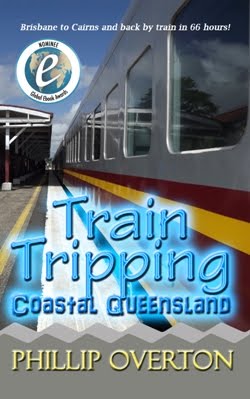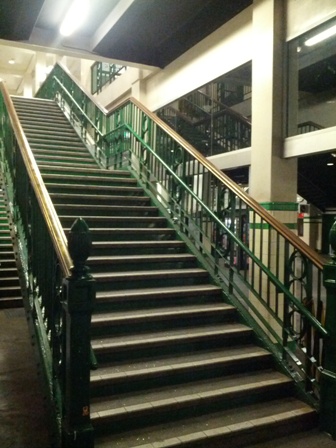
Gympie North Railway Station is an odd northern outpost on Queensland Rail's Citytrain network that sits miles from nowhere at the end of Rocky Ridge Road, 5 km from the heart of Gympie. With Gympie boasting a population of over 18,000 people, the decision to place the train station miles out of town came about in 1988, when Queensland's North Coast Line was straightened and electrified between Brisbane and Rockhampton.
 |
| A waiting shuttle bus outside the rather unimaginative entrance to Gympie North Station, February 2016. |
Gympie North Station is by no means anything special. The bland, garish pink concrete-sheet building that is spruced up only by an unimaginative curved corrugated iron entrance can best be described as ugly. Perhaps the saying out of sight, out of mind rings true in this northern city.
 |
| Gympie North's rather wide platform looking towards the south. Photo February 2016. |
The platform at Gympie North is wide, giving the impression that it was perhaps intended to be an island-style platform allowing for trains to pull up on both sides. Only it isn't, and the rails are located on the western side of the station platform. Despite the original track alignment that departed the North Coast Line near Monkland on Gympie's southern outskirts still being in place, the junction for where the old alignment rejoins today's North Coast Line is a little to the north of Gympie North Station. Approaching Gympie from the south over the original alignment, called for trains to tackle the 109 feet climb over the last mile into town, which probably explains why the railway line was moved 5 km to the east of town. Sitting in the bottom of a long man-made cutting, Gympie North Station can truly lay claim to being in the middle of nowhere.
 |
| A deserted looking yard and platform at Gympie North in February 2016. |
The railway first reached the town of Gympie in 1881, after gold was discovered in 1867. However, the rails didn't come from Brisbane, the Queensland capital some 168 km to the south, as most would have expected. Rather, the railway line first arrived from the port of Maryborough, some 87 km to the north. The line from Brisbane followed soon after in 1891. Gympie has a rich railway history that also lays claim to the 40 km long Mary Valley Branch Line that extended south-west of the city in 1914. So you would think that a new railway station constructed at the same time as Queensland hosting the World Expo in 1988 would have been celebrated with something more than a fibro construction building stuck in the bottom of a hole. Sadly, this important crossing point on Queensland's North Coast Line is exactly that. So with no trains in sight and the hot Queensland sun reflecting off the asphalt platform, I leave Gympie North Station behind, and head towards town to find the real Gympie Station. But as usual, that's a story for another day.
Gympie North was just one of the stations I stopped at in 2014 while travelling 3,362 km by train from Brisbane to Cairns and return to write by book Train Tripping Coastal Queensland. Inside is a station by station guide to the history and humour I unearthed from the window of a train. If you're thinking of travelling by train along Queensland's coast, or just curious as to how Queensland's North Coast Line was pieced together, then from just 99 cents you can download my Award Nominated eBook onto your PC, smartphone, iPad or tablet and turn your next train trip into a real railway adventure of your own.
Available now through my Books page
See also; Nambour: The Sunshine Coast Line














